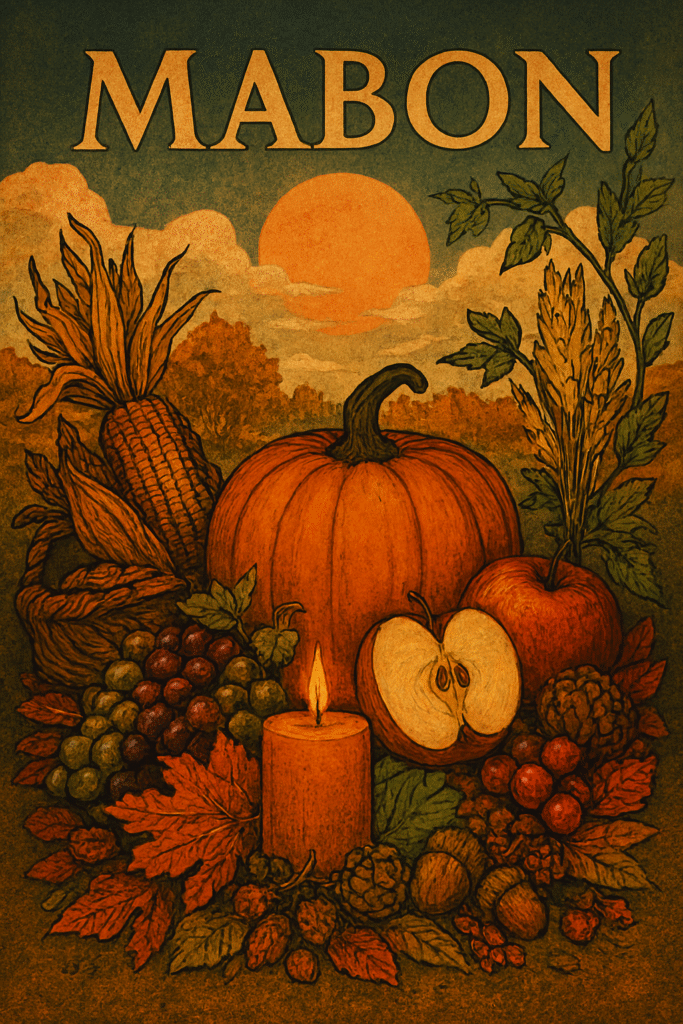
Mabon, celebrated between 21–24 September in the Northern Hemisphere, marks the Autumn Equinox—a moment of perfect balance between day and night. As the second harvest festival on the Wheel of the Year, Mabon invites reflection, gratitude, and preparation for the darker half of the year. Though not an ancient Celtic fire festival, Mabon has become a meaningful observance in modern Pagan and Wiccan traditions, honouring the turning of the seasons and the mysteries of transformation.
Historical Origins
The name “Mabon” was introduced in the 1970s by Aidan Kelly, a key figure in the development of contemporary Paganism. It references Mabon ap Modron, a figure from Welsh mythology found in the Mabinogion, a medieval collection of tales. Mabon, whose name means “Great Son,” was a divine youth associated with light, hunting, and rebirth. While the historical link between Mabon ap Modron and the equinox is tenuous, the name has been adopted to symbolise the themes of balance and transition.
Ancient cultures across Europe marked the equinox with rituals and architectural alignments. Neolithic sites such as Cairn T in Ireland and Mnajdra in Malta were built to align with the equinox sun. The Druids referred to this time as Mea’n Fo’mhair, honouring the Green Man and offering libations to trees and the land.
Folklore and Symbolism
Mabon is rich in symbolic meaning, reflecting the duality of light and dark, life and death:
- The Aging Goddess: In Wiccan lore, the Goddess transitions from her Mother aspect to Crone, preparing to guide the world into introspection and rest.
- The Waning God: The God, having reached his peak at Litha, now prepares for symbolic death and rebirth at Samhain.
- Persephone’s Descent: In mythic parallels, Mabon is associated with Persephone’s journey to the Underworld, marking the seasonal shift and the beginning of inner reflection.
- The Green Man: Honoured as the spirit of the forest, the Green Man represents the vitality of nature and its gradual withdrawal.
Symbols of Mabon include apples, pomegranates, acorns, pine cones, gourds, and horns of plenty. Colours such as russet, gold, maroon, and deep green reflect the changing landscape.
Rituals and Traditions
Mabon rituals focus on gratitude, balance, and release. Common practices include:
- Altar Creation: Altars are decorated with autumnal produce—squash, berries, apples—and symbols of the harvest.
- Feasting: Seasonal foods such as breads, root vegetables, nuts, and cider are shared in communal meals.
- Libations and Offerings: Wine, herbs, and grains are offered to trees or buried in the earth to honour the land’s generosity.
- Reflection and Release: Journaling, meditation, and ritual burning of written intentions help practitioners let go of what no longer serves.
- Nature Walks: Observing the changing foliage and gathering natural items for altars or crafts reinforces connection to the season.
Gift-Giving and Seasonal Offerings
Mabon gifts reflect themes of harvest, introspection, and preparation. Popular items include:
- Crystals: Stones such as lapis lazuli (wisdom), yellow agate (balance), and sapphire (clarity) are gifted to support seasonal reflection.
- Herbal Bundles: Autumn herbs like sage, marigold, and myrrh are tied for cleansing and grounding rituals.
- Cornucopia Decor: Horns of plenty filled with dried fruits, grains, and herbs symbolise abundance and gratitude.
- Seasonal Candles: Scented with autumn blends—benzoin, cinnamon, and clove—candles are used in rituals or gifted as tokens of warmth.
- Crafted Items: Wreaths, ivy garlands, and apple-themed crafts are exchanged to honour the season’s beauty and symbolism.
Conclusion
Mabon is a time of equilibrium, gratitude, and quiet transformation. As the light wanes and the earth prepares for rest, practitioners are invited to reflect on their personal harvests, honour the gifts of the season, and begin the inward journey toward Samhain. Through ritual, folklore, and symbolic gifts, Mabon offers a moment to pause, give thanks, and embrace the wisdom of balance.
